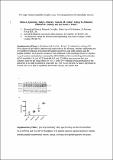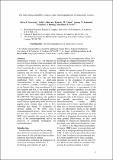Files in this item
The major histocompatibility complex class I immunopeptidome of extracellular vesicles
Item metadata
| dc.contributor.author | Synowsky, Silvia A. | |
| dc.contributor.author | Shirran, Sally L. | |
| dc.contributor.author | Cooke, Fiona G. M. | |
| dc.contributor.author | Antoniou, Antony N. | |
| dc.contributor.author | Botting, Catherine H. | |
| dc.contributor.author | Powis, Simon J. | |
| dc.date.accessioned | 2017-09-01T11:30:11Z | |
| dc.date.available | 2017-09-01T11:30:11Z | |
| dc.date.issued | 2017-10-13 | |
| dc.identifier | 250989908 | |
| dc.identifier | d085c318-391b-4a38-8606-7297c2728cf2 | |
| dc.identifier | 85031329578 | |
| dc.identifier | 000413140600027 | |
| dc.identifier.citation | Synowsky , S A , Shirran , S L , Cooke , F G M , Antoniou , A N , Botting , C H & Powis , S J 2017 , ' The major histocompatibility complex class I immunopeptidome of extracellular vesicles ' , Journal of Biological Chemistry , vol. 292 , pp. 17084-17092 . https://doi.org/10.1074/jbc.M117.805895 | en |
| dc.identifier.issn | 0021-9258 | |
| dc.identifier.other | ORCID: /0000-0003-3516-3507/work/36476312 | |
| dc.identifier.other | ORCID: /0000-0003-4218-2984/work/60195324 | |
| dc.identifier.uri | https://hdl.handle.net/10023/11593 | |
| dc.description | This work was funded by the Melville Trust for the Care and Cure of Cancer, Scotland, UK. | en |
| dc.description.abstract | Extracellular vesicles (EVs) are released by most cell types and have been associated with multiple immunomodulatory functions. MHC class I molecules have crucial roles in antigen presentation and in eliciting immune responses and are known to be incorporated into EVs. However, the MHC class Iimmunopeptidome of EVs has not been established. Here, using a small-scale immunoisolation of the antigen serotypes HLA-A*02:01 and HLA-B*27:05 expressed on the Epstein–Barr virus–transformed B cell line Jesthom and MS of the eluted peptides from both cells and EVs, we identified 516 peptides that bind either HLA-A*02:01 orHLA-B*27:05. Of importance, the predicted serotype-binding affinities and peptide-anchor motifs did not significantly differ between the peptide pools isolated from cells or EVs,indicating that during EV biogenesis, no obvious editing of the MHC class Iimmunopeptidome occurs. These results, for the first time, establish EVs as a source ofMHC class I peptides that can be used for the study of the immunopeptidome and in the discovery of potential neoantigens for immunotherapies. | |
| dc.format.extent | 3042684 | |
| dc.format.extent | 121394 | |
| dc.language.iso | eng | |
| dc.relation.ispartof | Journal of Biological Chemistry | en |
| dc.subject | Extracellular vesicles | en |
| dc.subject | Immunology | en |
| dc.subject | Major Histocompatibility Complex | en |
| dc.subject | Mass spectrometry (MS) | en |
| dc.subject | Proteomics | en |
| dc.subject | QD Chemistry | en |
| dc.subject | QH301 Biology | en |
| dc.subject | QR180 Immunology | en |
| dc.subject | RM Therapeutics. Pharmacology | en |
| dc.subject | DAS | en |
| dc.subject | BDC | en |
| dc.subject.lcc | QD | en |
| dc.subject.lcc | QH301 | en |
| dc.subject.lcc | QR180 | en |
| dc.subject.lcc | RM | en |
| dc.title | The major histocompatibility complex class I immunopeptidome of extracellular vesicles | en |
| dc.type | Journal article | en |
| dc.contributor.institution | University of St Andrews. School of Chemistry | en |
| dc.contributor.institution | University of St Andrews. School of Biology | en |
| dc.contributor.institution | University of St Andrews. School of Medicine | en |
| dc.contributor.institution | University of St Andrews. Cellular Medicine Division | en |
| dc.contributor.institution | University of St Andrews. EaSTCHEM | en |
| dc.contributor.institution | University of St Andrews. Biomedical Sciences Research Complex | en |
| dc.identifier.doi | 10.1074/jbc.M117.805895 | |
| dc.description.status | Peer reviewed | en |
This item appears in the following Collection(s)
Items in the St Andrews Research Repository are protected by copyright, with all rights reserved, unless otherwise indicated.


